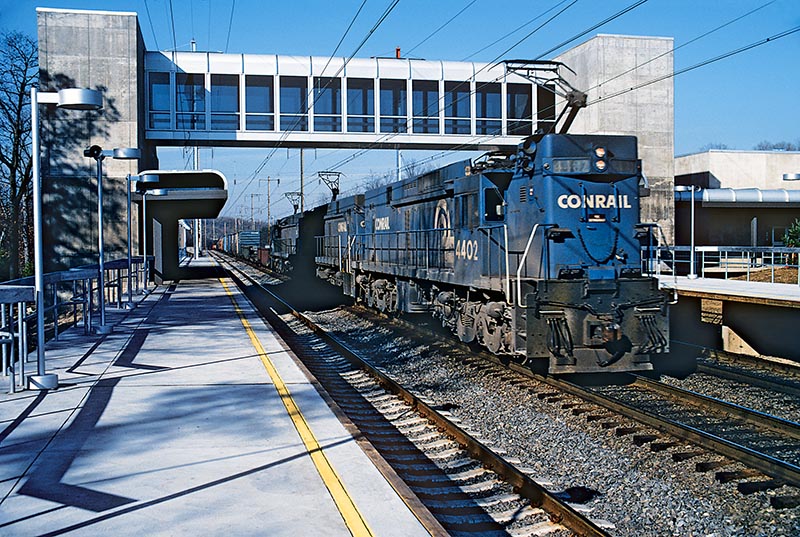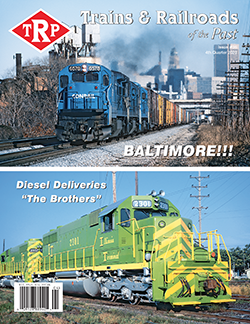 by TRP Staff/photos by Bill Kalkman
by TRP Staff/photos by Bill Kalkman
Frank Zappa has a little tune titled, “What’s New in Baltimore?” Well, the photos in this article aren’t exactly new, but they have been taken more recently than Gale Treiber’s vintage images you just enjoyed. Knowing Bill Kalkman’s extensive coverage of this city, I reached out to him to expand on what Gale presented. What you see here is an outstanding gallery of images that brings you into the 1970s and 1980s, when Baltimore had incredible color and variety, including Conrail’s daytime electric-powered freights, many manned towers, colorful short line action and foreign power that included western visitors and lightning-striped Delaware & Hudson locomotives. Chessie Cats prowled the region, but there was still plenty of power still wearing Baltimore & Ohio, Chesapeake & Ohio, and Western Maryland markings. So have a second cup of coffee with those eggs and scrapple, Hon, and enjoy a tour of Baltimore’s railroads in the early Conrail era.
Pennsylvania Railroad Northeast Corridor: The Pennsylvania Railroad main line from Washington, D.C., enters the scene near the bottom left corner of the map. It heads almost due north to a connection with the Western Maryland at Fulton Junction and immediately turns east to enter the B&P tunnels, exiting at Penn Station, where a connection is made with the Northern Central, which runs to York, Pennsylvania, Harrisburg and points north and west.
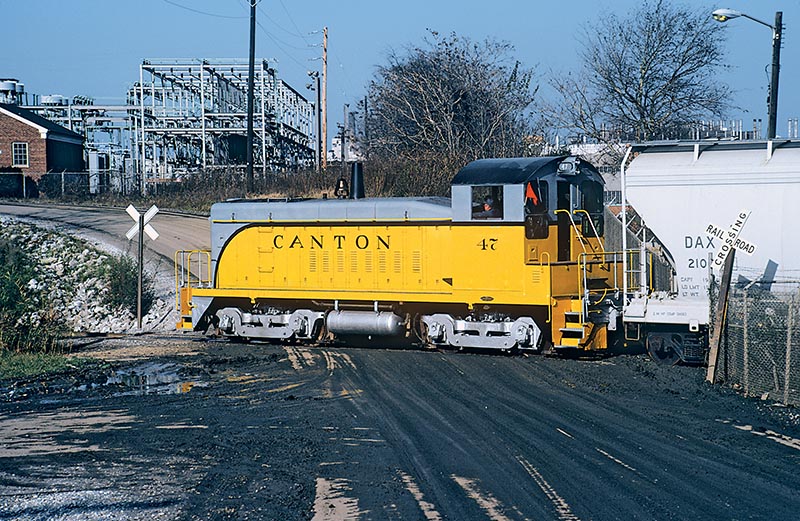
ABOVE: Brightly painted Canton Railroad SW900 47 is switching at the Western Electric plant in East Baltimore, Md., 1:00 p.m. on December 4, 1982. This diesel was built new for Canton in December of 1956, but looks like it just left the showroom. That’s the Baltimore Gas & Electric’s Newgate Substation on Vail Street on the hill.
The Northern Central branch runs south down Monument Street and Central Avenue. Continuing through the Union Tunnels, the main line heads for Canton Junction, where PRR’s line to the docks at Canton and the Bethlehem Steel complex at Sparrows Point diverge from the main line. At Bay Tower, a number of lines converge, including the B&O main line and PRR’s President Street branch from the docks on the waterfront that includes a myriad of street running. The main line continues north-east past Bay Tower and on to Philadelphia and New York.
Baltimore & Ohio Main Line: The B&O main from Philadelphia enters the scene near Bay tower (where the Sparrows Point Sub diverges) and heads west to the Penn Station area before turning due south and entering the Howard Street tunnel. It emerges at Camden Station near the present site of the Baltimore Orioles’ baseball stadium at Camden yards, which incorporates the old B&O freight house. At Bailey Wye, the main follows the west leg and continues to Relay, where the Washington branch diverges from the Old Main Line to Cumberland and Chicago.
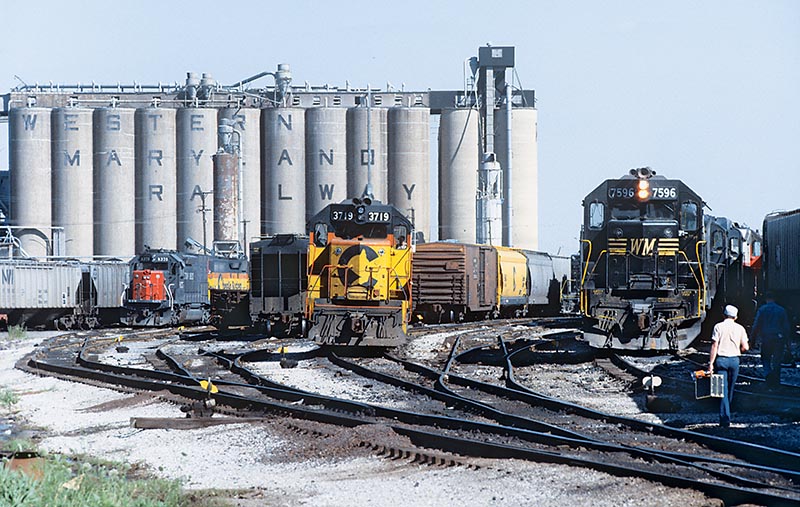
ABOVE: In a fascinating scene with a motive power smorgasbord, another run-through Cotton Belt diesel, SSW SD40T-2 tunnel motor 8375, is sharing the yard with Baltimore & Ohio GP40 3719 and Western Maryland SD40 7596, who are all waiting for their next assignments at Port Covington on June 28, 1978, at 4:35 p.m. There is no doubt as to the identity of the owner of this facility located on the Middle Branch of the Patapsco River. The 1973 Chessie System merger of the B&O, C&O and WM precipitated the closing of Port Covington.
Western Maryland: The Western Maryland Railway main line approaches Baltimore from the northwest and at Walbrook Jct., the Tide Subdivision heads south and east to WM’s sprawling maritime transfer facility at Port Covington. WM’s very short Walbrook Sub meets the Pennsy at Fulton Jct., where trackage rights over PRR’s electrified main line and Northern Central branch are utilized to reach their Hillen pas-senger station, located just east of PRR’s Calvert St. station.
Short Lines: There are a few shortline railroads that played critical roles in Baltimore’s rail scene. First is the famous Maryland & Pennsylvania (Ma & Pa), whose main line from York enters the map region from the northeast, terminating at North Avenue & Howard Street near their passenger station. The Baltimore & Annapolis Railroad shops were located at Fernley, near the south edge of the map. The B&A was the successor to the Washington, Baltimore & Annapolis Electric Railroad, which terminated at B&O’s Camden Station, but pulled the plug in 1950, acquiring a GE 70-ton diesel for freight service. In 1989, the MTA purchased the B&A right of way for light rail operations and reinstated electrified passenger (commuter) service over part of the line. The Canton Railroad continues in operation today (see Railfan & Railroad August 2023 issue), operating in the harbor and industrial district east of the Patapsco River.
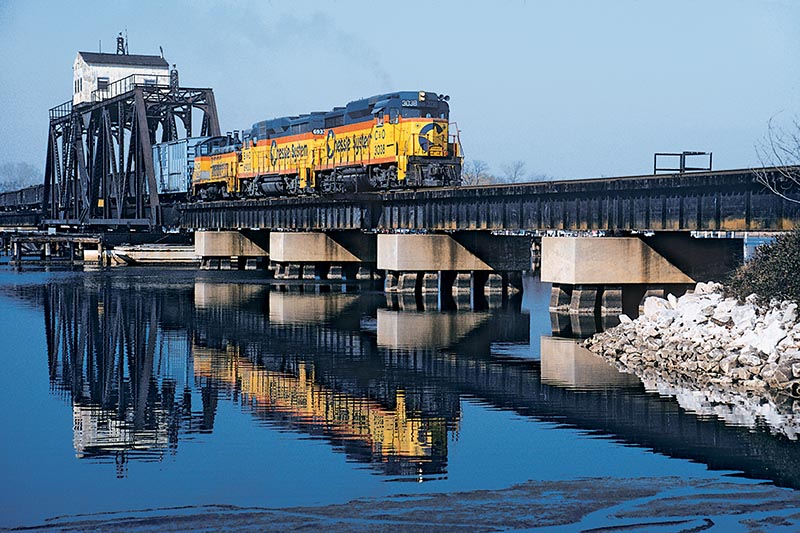
ABOVE: On January 18, 1986, Chessie System GP30’s 3038 and 6933, with NW2 9562, are on the point of the westbound “Grays Man” as they cross Bear Creek on the Sparrows Point Industrial Track in Dundalk, Md. Grays Yard and the Bethlehem Steel Plant are just ahead.
Mass Transit: Baltimore was loaded with surface trolley lines (shown in dotted light blue on map) and a subway was opened in 1983, running from Charles Center downtown (surprisingly does not connect to the light rail system) to Reisterstown Road, just inside the Beltway. It was later extended along the median of I-795 to Owings Mills on the west end and Johns Hopkins Hospital to the east. The subway remains underground from downtown to Mondawmin, where trains emerge from beneath the surface of the Earth and parallel the Western Maryland main line from “Druid” to the Beltway…


